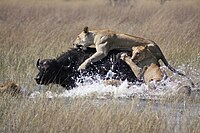
Triclosan and Methyl Triclosan in Prey Fish in a Wastewater‐Influenced Estuary
Sign Up to like & getrecommendations! Published in 2023 at "Environmental Toxicology and Chemistry"
DOI: 10.1002/etc.5557
Abstract: While the antimicrobial ingredient triclosan has been widely monitored in the environment, much less is known about the occurrence and toxicity of its major transformation product, methyl triclosan. An improved method was developed and validated… read more here.
Keywords: wastewater; prey fish; methyl triclosan; triclosan ... See more keywords

Delayed effects of prey fish quality and winter temperature during the birth year on adult size and reproductive rate of Baltic grey seals
Sign Up to like & getrecommendations! Published in 2019 at "Mammal Research"
DOI: 10.1007/s13364-019-00454-1
Abstract: Environmental conditions of mammalian juveniles may have delayed effects on their life histories and fitness, such as body size or reproductive rate later in their lives. In the present study, we tested this hypothesis on… read more here.
Keywords: fish quality; size; rate; grey seals ... See more keywords

Feeding habit transition induced by social learning through CaMKII signaling in Chinese perch (Siniperca chuatsi)
Sign Up to like & getrecommendations! Published in 2021 at "Aquaculture"
DOI: 10.1016/j.aquaculture.2020.736211
Abstract: Abstract Social learning plays pivotal roles in gaining new foraging skills and food preferences. However, the molecular mechanism underlying the effects of social learning on feeding habits is unclear. Chinese perch, as a demersal piscivore,… read more here.
Keywords: feeding habit; perch; chinese perch; prey fish ... See more keywords

High Lipid Content of Prey Fish and n−3 PUFA Peroxidation Impair the Thiamine Status of Feeding-Migrating Atlantic Salmon (Salmo salar) and Is Reflected in Hepatic Biochemical Indices
Sign Up to like & getrecommendations! Published in 2022 at "Biomolecules"
DOI: 10.3390/biom12040526
Abstract: Signs of impaired thiamine (vitamin B1) status in feeding-migrating Atlantic salmon (Salmo salar) were studied in three Baltic Sea areas, which differ in the proportion and nutritional composition of prey fish sprat (Sprattus sprattus) and… read more here.
Keywords: thiamine; thiamine status; prey fish; concentration ... See more keywords